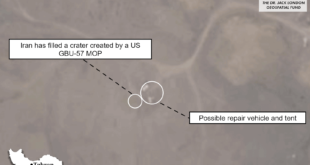A NEW TECHNIQUE using satellite radar images may hold the key to providing the water needs of 200,000 Sudanese living in sweltering heat in camps along the Chadian border.
Alain Gachet, a geologist who spent most of his working life exploring for oil and mining companies, has developed a system that uses satellites orbiting 800km above the earth to search for water.
A good deal of geological exploration now uses the visual images produced by Nasa shuttle missions.
But this only sees the surface features of the earth. Gachet uses two forms of radar to look deep below the soil.
“C Band Radar penetrates to a depth of 50cm, while L Band goes down to a maximum of 20m,†says Gachet.
By using all three systems, it is possible to plot likely areas for illing across vast areas. The watersheds in the region can be mapped, the slope of the land and — most importantly — the best sites for illing.
This work is carried out from an office in the town of Tarascon, in the French region of Provence, where Gachet works surrounded by the objects he has collected over many years of work in Africa.
The results have been amatic. Although Gachet is cautious about his findings, he believes that this technique can double the success rate of water exploration in the region.
In March 2004, the United Nations refugee agency, UNHCR, asked Gachet to carry out a pilot survey of eastern Chad.
“By July 2004, we supplied water target maps covering over 22,500 sq. km of territory around the refugee camps of Oure Cassoni, Touloum and Iridimi,†says Gachet.
Comparing the optical and the radar images of the area around Iridimi refugee camp in Chad illustrates the potential.
The photograph shows the wadi, or y river bed, on the left of the picture, with red dots showing y wells and blue dots the productive wells.
Red lines are the fractures, which could hold water.
There is no real way of knowing why some wells provide water while others are y. But the radar image is clear.
The black areas are y, while the bright areas have the potential to hold water.
The three red dots, indicating y wells are in the black and therefore y area, while the blue dots are on the bright areas or on a fracture.
Firoz Verjee, from Institute for Crisis, Disaster and Risk Management at George Washington University, says that while some of these applications have been developed in laboratory and scientific conditions, this is the first time Gachet’s approach has been applied in a large-scale, humanitarian crisis.
“This is a promising example of how space technologies can have a practical and critical role in humanitarian assistance and international development,†said Verjee.
Craig Sanders, head of operations in Chad and Darfur for the UNHCR, says the technique is unique: “It has saved us a lot of time and energy searching for water in an area twice the size of Switzerland.
“This tool allow us to focus on the best areas to ill. It is not a panacea — we still have to prove the results on the ground. But it has helped us a lot.â€
Water is one of the UN’s most serious problems in eastern Chad. The area is not only extremely remote it is also sandy, with almost no surface water.
The refugee camps are row after row of tents, pitched on flat, desolate areas.
Finding water is a top priority, but such is the difficulty that in some camps water supplies have had to be rationed. Instead of receiving 15 litres a day, each person is limited to just five litres for all the refugees needs, including washing, cooking and inking.
With the heat rising to 50؛C, this is a tiny quantity. There have been intermittent clashes with local people over wood and water, which underlines the importance of finding fresh supplies.
When the conflict in Sudan’s western Darfur region finally ends, the new wells discovered using these techniques will continue to serve the people of eastern Chad.
UNHCR’s Jennifer Pagonis says Gachet’s study “paves the way towards sustainable water management in the region.â€
 Eurasia Press & News
Eurasia Press & News



